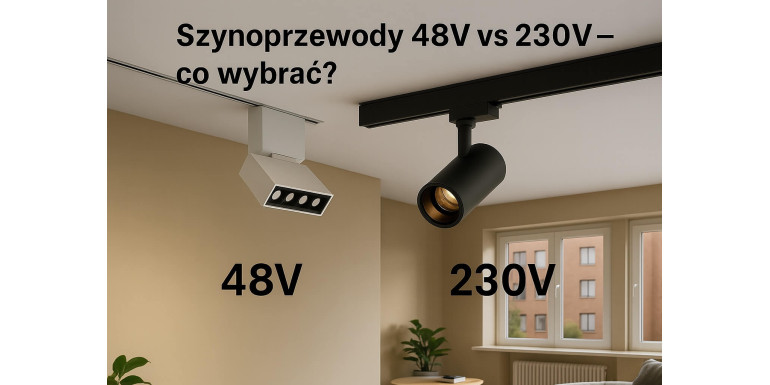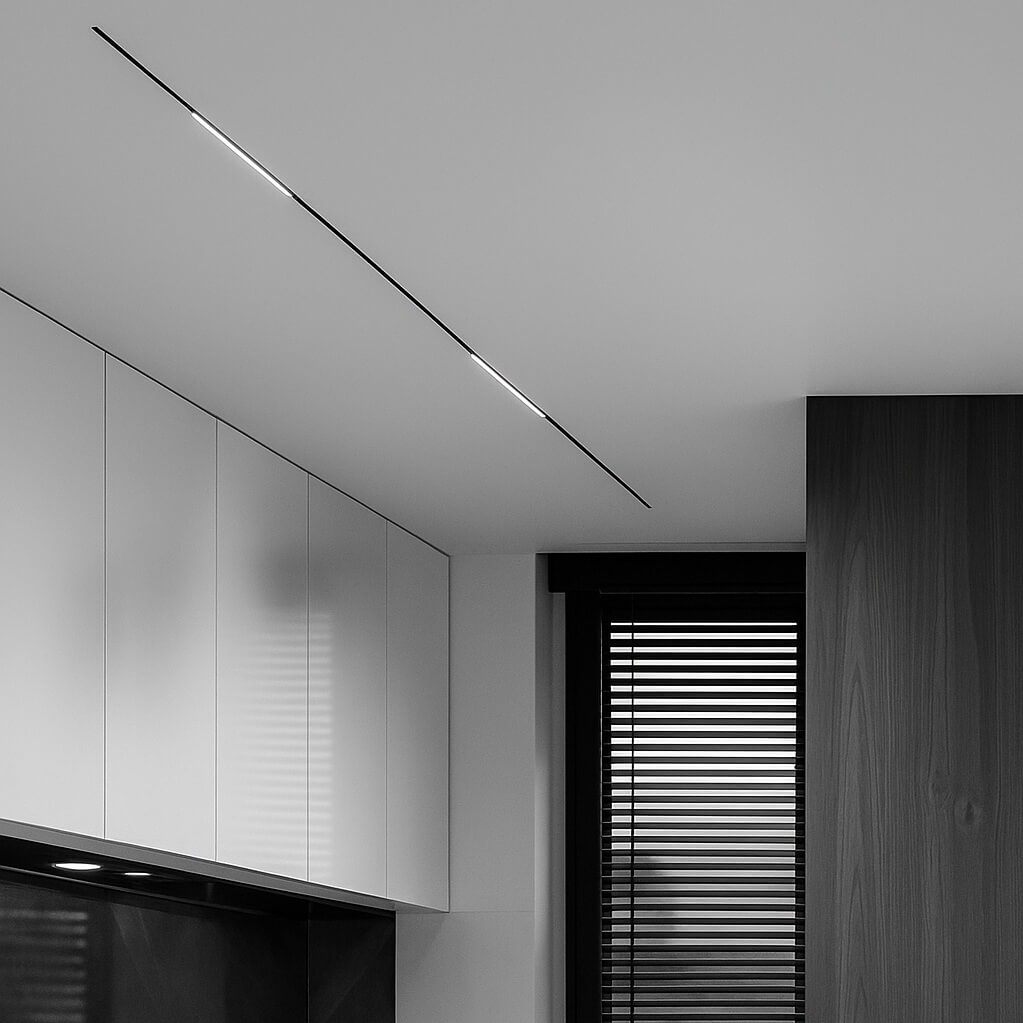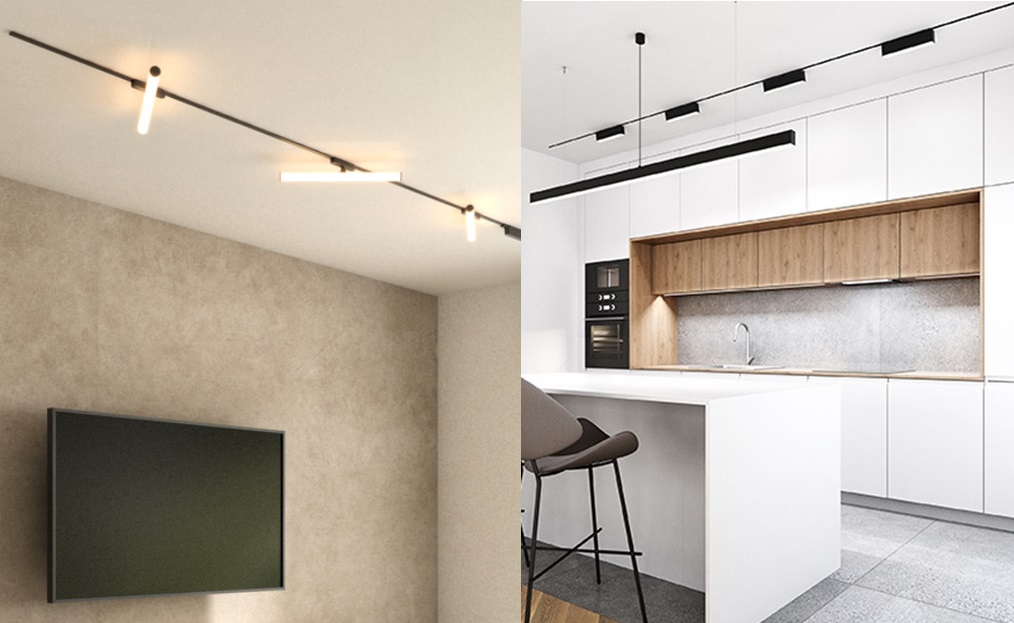-
LED ceiling lamp or pendant lamp? Which one to choose for your living room? 09/05/2025 10:46:26Magnetic tracks – how do they work and why are they so fashionable? 08/18/2025 09:59:13How to Brighten Up a Hallway? Practical Ideas Using LED Wall Lights 08/04/2025 15:08:1048V or 230V tracks – Which to Choose? Expert Guide07/23/2025 11:18:55

48V vs 230V Track Systems – Which One Should You Choose?
Track lighting systems have evolved from purely functional setups into refined, aesthetic lighting solutions for modern interiors. Their popularity continues to grow in residential, commercial, office, and hospitality spaces alike. One of the key decisions when designing such a system is choosing the power supply: low-voltage 48V or standard 230V?
As lighting technology experts, we’ve prepared this in-depth guide to help you understand the technical differences between the two systems—and more importantly, to select the right one for your space, investment needs, and user expectations.
The Fundamental Difference: Voltage Supply
The most basic difference between these two systems lies in their operating voltage:
-
230V systems are powered directly from the mains electrical grid.
-
48V systems require an external power supply (transformer) that steps the voltage down to a safe 48 volts.
This seemingly minor difference has far-reaching implications for aesthetics, technical capabilities, installation, maintenance, and smart home compatibility.
48V Systems – Innovation and Precision
Low-voltage track systems (48V) are setting the standard for the future of architectural lighting. Their key advantages include:
Design and aesthetics: Ultra-slim, minimalist profiles; miniature plug-in or magnetic fixtures; and the ability to almost completely hide the system within a suspended ceiling. This makes them the top choice for premium interior design projects. One of the most advanced options available is the Fivetrack magnetic rail, with a width of just 5mm—virtually invisible on the ceiling.
Safety: 48V is classified as SELV (Safety Extra-Low Voltage), making it safe for use in child-accessible areas, on walls, or in public interiors.
Layout flexibility: Magnetic track systems allow quick and easy changes to fixture placement—ideal for homes, galleries, showrooms, and dynamic retail spaces.
Smart integration: Full compatibility with smart systems like DALI, Tuya, ZigBee, or mobile apps makes 48V ideal for connected, intelligent interiors.

230V Systems – Simplicity, Power, and Reliability
Mains-powered track systems (230V) have been a tried-and-true solution for years, especially in commercial and public-use spaces. Their primary features include:
No transformer needed: Direct connection to the electrical network simplifies installation and reduces the number of components.
Higher power output: Supports fixtures with greater wattage, making this system perfect for high ceilings or areas that demand strong lighting.
Lower upfront costs: With no need for transformers and simpler installation, 230V systems are more budget-friendly at the outset.
Wide availability: A broad range of spotlights and LED fixtures are designed specifically for 230V tracks and are available at competitive prices.

Installation Differences – What You Should Know
1. Space for power supply (48V only):
48V systems require space to mount a transformer—usually in a suspended ceiling, cabinet, or bulkhead. This needs to be factored into the project plan and often requires an electrician's input. Some 48V systems offer track-integrated power supplies, but this may compromise the visual appeal.2. Connection method:
230V tracks connect directly to the electrical circuit. 48V tracks connect via a power supply unit, which then feeds the tracks.3. Ceiling types and finish aesthetics:
48V systems excel in suspended ceilings or any project aiming for invisible lighting infrastructure. 230V systems are often surface-mounted or suspended—less discreet, but easier to install.4. Safety during installation:
Working with 230V requires care and proper certification. 48V systems are safer and easier to handle during both installation and maintenance, with no risk of electric shock.When Should You Choose 48V?
-
You’re designing a modern interior and want a sleek, visually refined setup.
-
You need flexibility to easily rearrange fixtures.
-
You want a fully integrated, flush lighting system with no visible components.
-
Safety and smart home compatibility are a priority.
-
You plan to use lighting scenes and control lights via an app.
-
Your lighting plan includes both ceilings and walls.
When Is 230V the Better Choice?
-
The project needs to be cost-optimized.
-
You prefer a simple and fast installation.
-
You require powerful fixtures for technical or industrial lighting.
-
The lighting system must be divided into three independent circuits.
-
There’s no room to hide a transformer.
-
You’re outfitting a store, office, or gallery and need many fixtures.
Expert Summary
There is no universally “better” system. Both 48V and 230V have their rightful place in modern lighting design.
-
48V is the future-forward solution: safe, sleek, flexible, and highly aesthetic—crafted for discerning investors and interior architects. It’s constantly evolving with new tracks, miniaturized fixtures, and an emphasis on letting the light—not the lamp—be the hero.
-
230V is the classic workhorse: simple, reliable, budget-friendly, and easy to implement—even in basic renovations or large-scale lighting projects.
Your choice should be guided by a technical analysis, available budget, design goals, and lighting performance expectations. For recessed installations, magnetic track systems offer the most aesthetic finish—regardless of voltage. On a tight budget, 230V systems (especially single-phase 1F setups) remain the most cost-effective option.
Need help choosing the right system or developing a project plan?
Get in touch with our technical team—we’ll help you find the perfect solution for your investment.
Menu
- +Outdoor lighting
- +Indoor lighting
- Living room
- Bedroom
- Dining room
- LED bathroom lighting
- LED kitchen lighting
- LED stairs lighting
- +LED bulbs
- All manufacturers
- Prices drop
- New Products
- Bestseller




